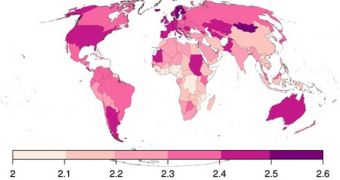According to the conclusions of a paper published in the December 2 issue of the esteemed journal Proceedings of the National Academy of Sciences (PNAS), it would appear that the world is now consuming a lot more meat than ever before.
Most of this increase is accounted for by China and India, even though many other countries around the world are reporting decreased meat consumption levels. These results were extracted from a comprehensive study of global food consumption patterns.
This research is the first-ever to calculate our position in the planetary food chain, a measure called trophic level. The value the team determined shattered older preconceptions that placed us on par with the world's top predators, Nature reports.
Scientists with the French Research Institute for Exploitation of the Sea, in Sète, say that humans occupy a global median trophic level of 2.21, similar to that of omnivore species such as anchovies and pigs. By comparison, plants and algae are at trophic level 1, small mammals at 2, larger mammals at 3. The classification ends with creatures such as polar bears and orcas, which stand comfortably at level 5.5.
“We are closer to herbivore than carnivore,” says Bonhommeau. “It changes the preconception of being top predator,” explains FRIES fisheries scientist Sylvain Bonhommeau, the leader of the new research.
Another important aspect of the study was that researchers were able to calculate the trophic level for 176 countries around the world, for a period of time from 1961 to 2009. A total of 102 food items were considered in the investigation. The data were collected from the UN Food and Agriculture Organization (FAO).
A careful analysis of the information revealed that our trophic level increased by about 0.06 percent over the past 50 years, particularly because humanity began consuming more meat and fat.
“It seems like a small difference, but when you think about how it’s calculated, it’s big. A change by 0.1 means you are eating considerably more meat or animal-based foods,” comments environmental scientist Thomas Kastner, from the Alpen-Adria University, in Vienna, Austria. He was not a part of the new study.
“If we all increase our trophic level, we’ll start to have a bigger impact on ecosystems,” Bonhommeau concludes.

 14 DAY TRIAL //
14 DAY TRIAL //